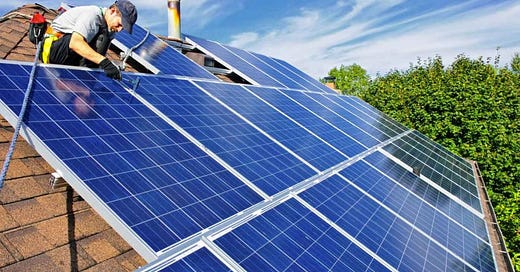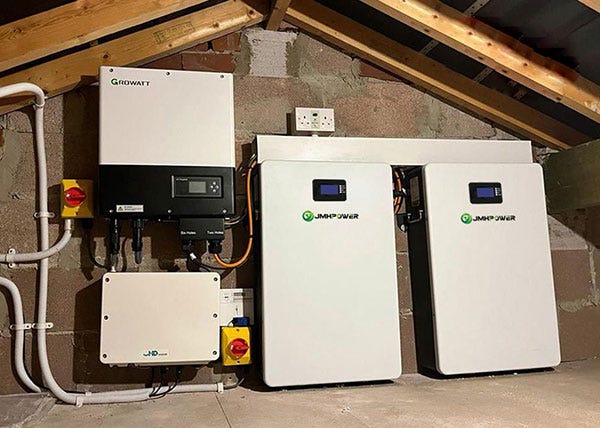https://arena.gov.au/assets/2017/08/AdobeStock_26232669-e1504207627601-1024x564.jpeg
https://www.abc.net.au/news/2025-05-07/government-home-battery-discount-explained/105257914?utm_campaign=abc_news_web&utm_content=link&utm_medium=content_shared&utm_source=abc_news_web
Michael’s Curious World is reader-supported. Become a free or paid subscriber for full access to posts, to the archive of past posts, to my ‘Newbies Guide to Substack’ and to support this curious journey. Interesting. Surprising. Fun.
ONE of the positive results of last weekend’s big election win for the Albanese Labor Government in Australia is it will accelerate the surge towards making the continent powered by renewables.
Australia already leads the world in the percentage of solar households with over four million installs, and that will speed-up because of political certainty.
During the campaign the Albanese Government announced a 30% subsidy for the cost of batteries, in addition to existing subsidies for solar panels (see story link above for more details).
The aim is to install one million batteries by 2030. Australia is already at 45% renewable electricity and is aiming to pass 80% by 2035, which seems achievable.
As many of my subscribers are outside Australia and might be curious about what is going on, I thought I’d post a summary and a link to more information. Australia really is leading the world here, and other countries would be smart to copy us.
The entire electricity network is being reinvented to be based on renewables. Governments are building six long eastern states transmission networks - three in Queensland, two in NSW and one in Victoria, plus a new link between South Australia and NSW and another link from the Snowy Hydro 2 scheme, which is under construction. Western Australia, being so far away, has a separate electricity system.
Investors are queuing to back inland solar and wind farms which will connect to these transmission routes and carry renewable electricity to the coastal populations. Grid-scale battery farms are also being installed, some replacing worn-out coal-fired electricity stations.
But it is away from the grid on rooftops in the suburbs where the biggest revolution is taking place. About 40% of households now have solar panels and about 30% of new solar installations now include home batteries. It is a quiet revolution.
https://jmhpower.com/wp-content/uploads/2024/07/Solar-Battery-Home-Storage.jpg
The Albanese Government’s 30% battery subsidy will turbocharge the renewable revolution.
It is now possible to buy a modest 5-6 kW home battery for about $5-6,000, which will be reduced by 30% once the battery subsidy scheme starts from July 1.
That size battery should be large enough to power most households overnight, reducing or eliminating the need to draw power from the grid, and then be recharged the following day with free sunshine. Even if it rains, solar still works, just more slowly.
How do I know that? Because our caravan, which has solar power and a lithium battery, has gone for as long as 56 nights without needing to plug into the grid for recharging, even in cloudy weather. It’s just a matter of matching demand to supply.
All around the country people see their household solar systems reducing or eliminating their power bills. It is happening everywhere, and people see it works, automatically. Just watch the meter.
This is why the Dutton Opposition’s alternative plan to restrict renewables and instead build seven nuclear power stations was so comprehensively rejected by the voters last weekend. Voters thought nuclear was simply unnecessary, when renewables can do the job at far less cost.
Those nuclear power stations would have had to have been government-owned, since investors favour renewables, causing a huge explosion of government debt of up to $600 billion by some estimates.
And it would have taken at least 15 years to build the first nuclear station, assuming the federal parliament and state parliaments had rescinded their bans on nuclear in Australia, which is extremely unlikely. Nuclear was always dead in the water and the voters have killed it off.
Demand for solar was already high and the certainty provided by the re-election of the Albanese Government will only encourage more people to go solar.
Personally, we already have 6.8kW of solar panels on the roof of our Queensland house and I have been watching the numbers on batteries for some time. Now I’ve decided the time has come. To get 30% off a $6000 battery is too good a deal to miss.
It should be noted that everyone benefits from more solar and batteries, not just those who actually install them. Reducing the amount of electricity which households draw from the grid lowers the price of that electricity on the National Energy Market, on which generators bid to supply 15 minute blocks of electricity to meet grid demand. Renewable electricity is always cheaper than coal power.
Curbing household demand also reduces the need to upgrade the grid to cope with peak demand, since that peak demand is made lower by households reducing their drain on the grid, so power companies can charge less.
One of the reasons solar panels and batteries are so cheap in Australia is there is NIL import tariff on equipment brought in mostly from China, although there are at least two solar panel manufacturers in Australia and a program to boost local battery manufacture.
Interestingly, the technical breakthrough which made solar panels viable was achieved by researchers at a university in Sydney. A Chinese student then went back to China and started a company which is now one of the world’s largest.
So, while the USA is slashing university research funding and has hit China with such huge tariffs that imports are halting, Australia is going the other way and exploiting research and cheap manufacturing techniques to benefit Australia.
Co-operation is in our national interest. Americans, take note!





